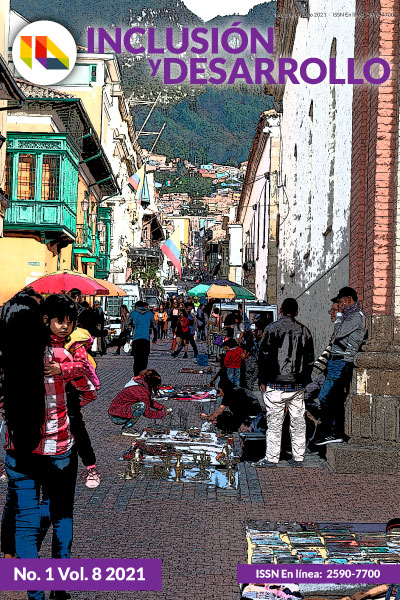Soporte social y estructuras habitacionales en la calidad de vida de las familias en la zona 1, comas 2019
Barra lateral del artículo
Cómo citar
Altmetrics
Detalles del artículo

Esta obra está bajo una licencia internacional Creative Commons Atribución 4.0.
Contenido principal del artículo
Resumen
La investigación soporte social y estructuras habitacionales en la calidad de vida de las familias en la zona 1 Comas 2019, objetivo fue determinar la incidencia del Soporte social y estructuras habitacionales en la calidad de vida de las familias en la zona 1 Comas 2019. Con enfoque cuantitativo, tipo sustantiva y diseño no experimental. Una población de 8751 familias de la zona 1 del distrito de Comas, una muestra de 368 estudiantes extraídos mediante muestro probabilístico. Se realizó la validez de los instrumentos de soporte social, estructuras habitacionales y calidad de vida, la confiabilidad tomó con los resultados y el reporte de soporte emocional fue de 0.948, variable de estructuras habitacionales tuvo el valor de 0.986 y calidad de vida de 0.950 indicando el coeficiente de Alfa de Cronbach tiene relación muy alta y en estadística inferencial se empleó la prueba de regresión lineal múltiple. Se concluyó que, existe incidencia de las condiciones del soporte social y las estructuras en la calidad de vida de las familias en la zona 1 Comas, 2019, el modelo logístico es significativo (p<0,05); se ajusta bien a los datos (Desviación con p><0,05); y explica el 64% de la variable dependiente calidad de vida. ><0,05); se ajusta bien a los datos de (Desviación con p<0,05); y explica el 64% de la variable dependiente calidad de vida.
Referencias
repositorio.uide.edu.ec/bitstream/37000/2431/1/T-UIDE-0698.pdf
Haramoto, E. (2002). Un sistema de información en vivienda. Una proposición preliminar. Revista planes de desarrollo urbano. 16(44), 211-230.
Hernández, R., Fernández, R. y Baptista, P. (2014). Metodología de la investigación. México: Mc Gram - Hill.
Janampa, R. (2018). Diseño estructural de un edificio multifamiliar de 5 pisos y un semisótano, Ate– 2018. (Tesis de maestría). Universidad César Vallejo, Perú.Recuperadode:http://repositorio.
ucv.edu.pe/bitstream/handle/UCV/35278/Janampa_CRM.pdf?seq uence=1&isAllowed=y
Jonkmann K., Thoemmes F., Lüdtke O. y Trautwein U. (2014). Personality traits and livingarrangements in young adulthood: selection and socialization. Dev Psychol, 50(3):683-698.
Recuperado de: DOI: 10.1037/a0034239.
Karstoft, K., Nielsen, T. y Nielsen, A. (2019). Measuring Social Support Among Soldiers With the Experienced Post-Deployment Social Support Scale (EPSSS): A Rasch-Based Construct
Validity Study. Behavioral Medicine, 2(2). 122-134. Recuperado de: https://doi.org/10.1080/08964289.2019.1676192
Landáruzi, M. y Mercado, J. (2004). Algunos factores físicos y psicológicos relacionados con la habitabilidad interna de la vivienda‖. Medio Ambiente y Comportamiento
Humano. 5.(1,2). 231-249.Recuperadode: https://repositorio.cepal.org/bitstream/handle/11362/2376/S2003000_es.pdf.txt
Maquera, J. (2015). Conjunto residencial para reducir el déficit habitacional en el distrito y provincia de Tacna. (Tesis de maestría) Universidad privada de Tacna, Perú. Recuperado de:
http://repositorio.upt.edu.pe/bitstream/UPT/85/1/maquera-turpo- jhony.pdf 0MS (1999). Vivienda saludable. Calidad de las condiciones de la vivienda
y calidad de vida. Recuperado de: http://webcache.googleusercontent.com/ search?q=cache:5hXYJ2Tb5xAJ:www.bvs de.paho.org/bvsasv/e/iniciativa/posicion/siete.
pdf+&cd=1&hl=es- 419&ct=clnk&gl=pe
Prieto, M. (2013). Condiciones habitacionales y calidad de vida urbana. El caso de la Ciudad de BahíaBlanca. Recuperado de: https://pdfs.semanticscholar.org/06a1/
c3cc2fe35e66601326d7622f5bb9c184cb1c.p df
Rashidah, N., Kaur, G., Ahmad, A. y Khalili, J. (2012). Housing Conditions and Quality of Life of the Urban Poor in Malaysia. Procedia-Social and Behavioral Sciences, 50(1); 827-833.
Recuperado de: https://doi.org/10.1016/j.sbspro.2012.08.085
Rocha, P. (2008). Social Support and Social Network in Family Nursing:Reviewing Concepts. Rev Latinoam Enferm, 16(2). 3 2 4 - 3 3 7 .
Recuperadode: http://www.scielo.br/scielo.php?script=sci_nlinks&ref=000100&pid=S0103-2100201200050002100001&lng=en
Sánchez, H. y Reyes, C. (2015). Metodología y diseño de la investigación científica. Perú: San Marcos
Stoppa, J. y Marchioro, N. (2012). Structure and Functionality of the Social Support Network for Adults with Cancer. Acta Paul. Enferm. 25(5). 231-245. Recuperado de: http://dx.doi.
org/10.1590/S0103-21002012000500021
Wanzirah, H., Tusting, L., Arinatwe, E., Katureebe, A., Katureebe, A., Maxwell, J., Rek, J., Bottomley, S., Moses, K., Dorsey, G., y Lindsay, S. (2017). Mind the Gap: House Structure
and the Risk of Malaria in Uganda. Plos One 10(1). 251-260. Recuperado de: https://doi.org/10.1371/journal.pone.0117396
Wu, H., Wu, S., Wu, H., Xia, Q. y Li, N. (2017). Living Arrangements and Health-Related Quality of Life in Chinese Adolescents Who Migrate from Rural to Urban Schools: Mediating
Effect of Social Support. Int J Environ Res Public Healthv, 14(10). 371- 380. Recuperado de: https://dx.doi.org/10.3390%2Fijerph





